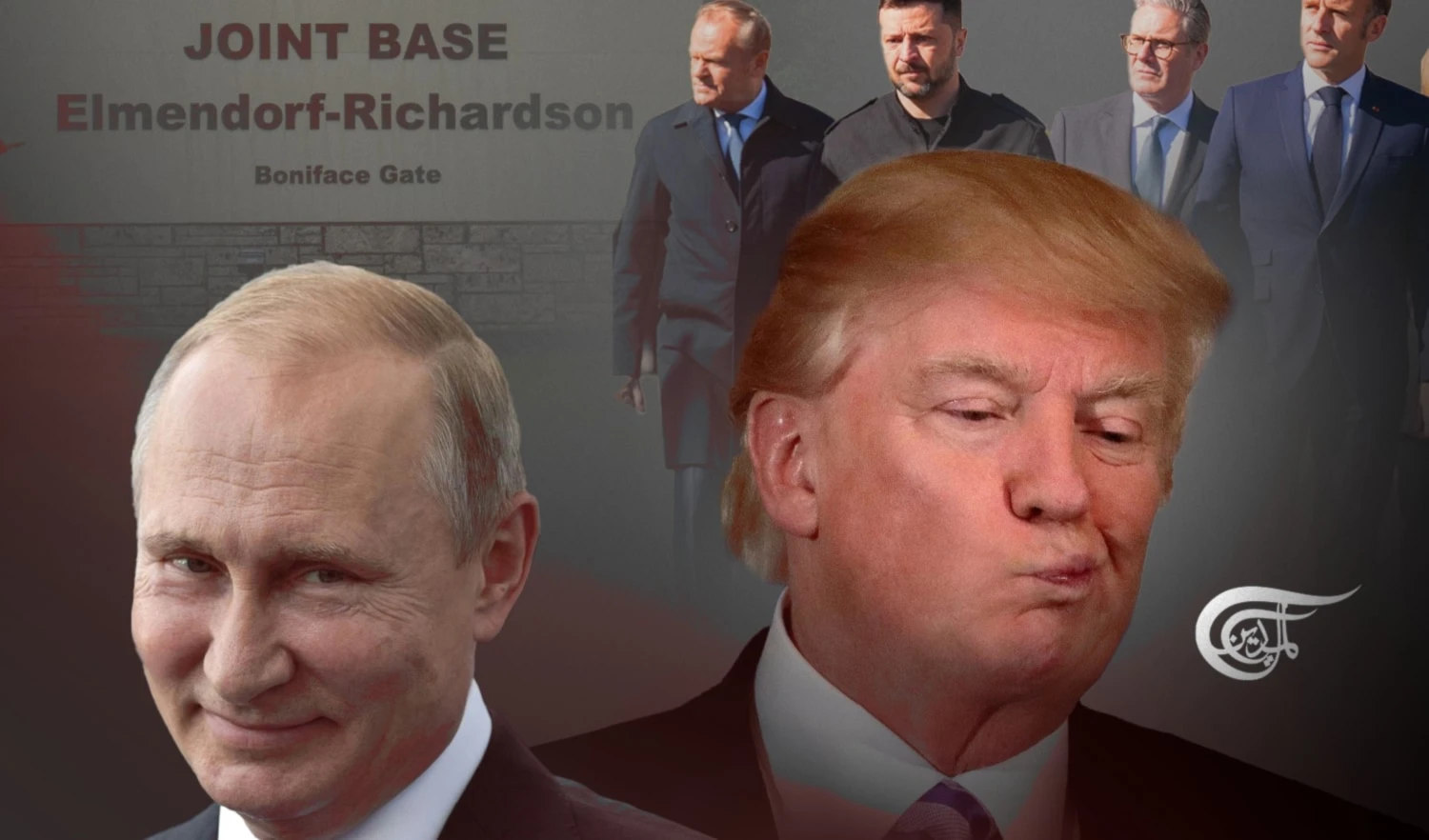How Netanyahu continues to pursue 'redrawing the map'
Netanyahu's recent visit to Washington and the rhetoric surrounding the trip leave the impression that there is no end in sight until the ongoing war.
-

Netanyahu is inventing what we can call the “new Israel” because the old Zionist vision appears to have collapsed (Illustrated by Batoul Chamas; Al Mayadeen English)
The Gaza ceasefire deal has no doubt inflicted a major embarrassment on Israeli Prime Minister Benjamin Netanyahu and his military, yet this has not signaled an end to the regional struggle in his eyes. The recent visit to Washington and the rhetoric surrounding the trip leave the impression that there is no end in sight until the ongoing war.
Israeli PM Netanyahu’s visit to the United States is clearly tailored to foster a US-Israeli aggressive takeover of West Asia. During his first term in office, US President Donald Trump set forth a new path for the Zionist regime aimed at crushing Palestinian statehood once and for all, in addition to stamping American dominance into the region.
While the infamous “Deal of the Century” plan may have seemingly collapsed upon its announcement in January of 2022, this proposal was simply one branch of a wider strategy that the Biden administration also attempted to continue growing. It was clear that the Trump administration, whose policies were led by hardline Zionist fanatics, was seeking to collapse the previous regional understanding of how to settle the Palestinian issue. This was the dismantlement of the “Arab Peace Initiative” of 2002, the longstanding accepted guide to stability ratified by the Arab League.
Replacing the Arab Peace Initiative, which affirmed that no normalization agreements would be signed without the establishment of a Palestinian State, the so-called “Abraham Accords” sought US power in order to coerce Arab regimes into normalizing ties in exchange for economic and security benefits. This initiative effectively deleted the Palestinian struggle from regional power dynamics and sought to redraw the status quo in a very dangerous manner.
Fast Forward to September of 2023, the US Biden administration was working to implement this new vision for US imperial domination in the emerging multi-polar world. At the G-20 summit in New Delhi, Joe Biden proudly announced the planned construction of the India-Middle East-Europe Economic Corridor. This new trade route was in line to bolster the American Partnership for Global Infrastructure and Investment (PGII), which was created with countering China’s innovative Belt and Road Initiative in mind.
The India-Middle East-Europe Economic Corridor sought to create a land trade route from the United Arab Emirates (UAE), through Saudi Arabia and Jordan, into Zionist-occupied Palestine. However, this was going to hedge upon Riyadh signing a normalization agreement with “Tel Aviv” first; which was close to being reached. That same month, Netanyahu delivered an aggressive speech at the United Nations General Assembly (UNGA) in which he presented the “New Middle East," featuring the Arab States that align with Israeli-US interests and Iran’s alliance.
All was set to go forth, except for one huge issue standing in the way that both the Israelis and the US completely underestimated: the determination of the Palestinian people. In the occupied West Bank, armed Resistance factions began forming for the first time since the Second Intifada in 2021, as tensions escalated year-in-year-out, as the Palestinian factions in the Gaza Strip prepared themselves for a war that would thwart the Zionist-American agenda and save their cause for self-determination.
Attempts to pave a way toward disrupting the Israeli-US plot to destroy the Palestinian cause for rights and self-determination, including mass nonviolent civil resistance and political maneuvers were ignored, only provoking further violence. Hence, Palestinians began taking matters into their own hands, especially due to a growing encroachment on al-Aqsa Mosque, the third Holiest Site in the Islamic faith, which sought to end the status quo inside the compound and even destroy the site to replace it with a synagogue.
During this period, the Israelis began working toward redefining their Zionist mission and deciding upon the future of the settler-colonial project. On one side, a part of the Zionist population sought to protect their status quo and maintain an Apartheid regime that granted Israeli Jews the benefits of a Western-style liberal democracy. The other side, led by Netanyahu, sought to overthrow the Israeli judiciary, Judaize the legal system, and seek expansionism into what is known as “Greater Israel”. Evidently, Netanyahu is getting his way.
One very important aspect of the ongoing conflict is power perception, and the Israeli-US alliance understands this well. Up until September of 2024, the Islamic Republic of Iran appeared to be in a position of unparalleled regional power, according to popular understanding. The Hamas-led attack of October 7, 2023, dismantled the image of the Israeli military, and its ensuing failure to defeat Palestinian armed groups in Gaza cemented this view, making Iran and its other allies appear extremely powerful.
In the aftermath of the Israeli booby-trapped pager attacks across Lebanon, which injured thousands and were labeled as terrorism by former CIA Director Leon Panetta, followed by the assassination of most of Hezbollah’s senior leadership, this perception dramatically shifted. Suddenly, in the propaganda war arena, the perception was that US-Israeli power was on top and Iran had been knocked down. Further cementing this view was the fall of the Syrian government led by its former President Bashar al-Assad.
While the Israelis gained the upper hand in the propaganda/media war front, the reality was that they had scored a series of tactical victories, while the power of Iran and allies had not actually diminished in the way that had been portrayed. Yet, this narrative is of great importance, because it also affects the trust between leadership and populations inside Iran and with its Axis of Resistance aligned allies.
The Gaza ceasefire/prisoner exchange has again altered the media view of the war regionally, as it has become evident that the Israelis failed to defeat Hamas despite committing genocide and using its full US-backed force.
Rationally, the Israelis knew that they weren’t going to win in a war with Hamas, therefore they agreed to the ceasefire and conceded a tactical loss of the propaganda front. But they will not wait long before attempting to salvage their image of strength and aggressing further, an example of this is already beginning to manifest itself in the occupied West Bank.
Israeli PM Netanyahu is hell-bent on “redrawing the map," expanding his colony’s occupation of Arab lands, while the Israeli regime threatens all its neighbors simultaneously. They are clear that they won’t leave Syria by choice, and even if the Israeli military withdraws from Lebanon, it stresses its need to maintain freedom of action inside the country. “Freedom of action” equals the right to run cross-border incursions and launch airstrikes at any time, which is unacceptable by any nation's standards.
Meanwhile, the Israeli military is committing the most extensive military campaign in the West Bank since 2002, labeling it “Operation Iron Wall”, which has already resulted in the murder of over 70 Palestinians. Usurpation of the territory is the ultimate goal, and since Donald Trump’s Presidential campaign was bankrolled with 100 billion dollars in order to allow this, it can be assumed that the US is on board with the land theft.
The Israelis and their American partners are seeking total domination of West Asia, not stopping until they achieve their goals; something that Netanyahu calls “total victory”. While some now fear the deterioration of the Gaza ceasefire in phase 2 of its implementation, along with Trump’s calls to ethnically cleanse the territory, the larger and more realistic threat is what will come of the post-war process there.
Ethnic cleansing will not be feasible, which makes it highly unrealistic and therefore it is most likely that Donald Trump is talking about this for the sake of Israeli domestic consumption and little else. If he is actually serious about such a plan, then this will almost certainly destabilize Egypt and Jordan. It could even lead to an Israeli invasion of the Sinai Peninsula, which it has already been working on justifying since at least October of 2024.
The idea of Jordan absorbing hundreds of thousands of Palestinians from Gaza would also likely spell enormous issues, the least of which will be the fledgling economy’s ability to deal with such a refugee population. Yet, the societal repercussions will be much greater and could lead the already agitated Jordanian public toward the path of resistance. Similarly, if the Zionist army invades Egypt, even if there’s no resistance from the Egyptian army at first, there is a high likelihood that resistance will emerge and both normalization agreements could collapse.
Netanyahu is inventing what we can call the “new Israel” because the old Zionist vision appears to have collapsed. In order to redefine the goals of his Zionist project, he is aiming to continue mass slaughter and even the destabilization of nations' leaderships who are friendly to the regime. It is an era of expansion, extermination, and subjugation. The aim will be to use as many collaborators in all their iterations in order to kill the Palestinian cause and make the region bow to US-backed Zionism. The only one that could change the course of the conflict is Donald Trump and his administration, which appears extremely unlikely, to say the least.

 Robert Inlakesh
Robert Inlakesh
 9 Min Read
9 Min Read











